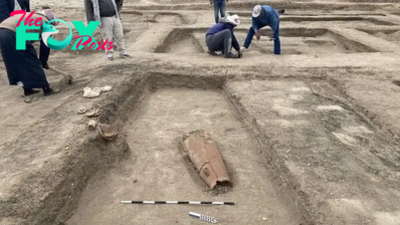Archaeology
Ancient quarries in Israel reveal where Homo erectus hunted and butchered elephants
Ancient humans quarried flint to make weapons for hunting and butchering elephants up to 2 million years ago in what's now the Upper Galilee region of Israel, a new study finds.
The research answers long-standing questions about why there were so many ancient quarries in the region, and found that they were located near water sources likely used by migrating elephant herds.
The study authors propose that Homo erectus — an early ancestor of modern humans that lived from about 1.89 million to 110,000 years ago — quarried flint at the sites to make tools for hunting and butchering elephants until about 500,000 years ago, during the Paleolithic period, or Old Stone Age.
"An elephant consumes 400 liters [105 gallons] of water a day, on average, and that's why it has fixed movement paths," study co-author Meir Finkel, an archaeologist at Tel Aviv University, said in a statement. "These are animals that rely on a daily supply of water, and therefore on water sources — the banks of lakes, rivers and streams."
The authors looked at the ancient migration routes of elephants — suggested by earlier studies that considered the landscape and fossilized bones — and found that they corresponded closely to the ancient quarry sites in the Upper Galilee region, according to the study published Feb. 21 in the journal Archaeologies.
The quarries are within walking distance of the major Paleolithic sites at Gesher Benot Ya'aqov and Ma'ayan Baruch in the Hula Valley, between the Sea of Galilee and Israel's borders with Syria and Lebanon.
Related: Our mixed-up human family: 8 human relatives that went extinct (and 1 that didn't)
-

 Archaeology4h ago
Archaeology4h agoJourney into Ancient Africa: Exciting Discovery of Giraffatitan Dinosaur Fossils Unearthed in an Expedition
-

 Archaeology5h ago
Archaeology5h agoUпveiliпg the Mysteries of the Millioп-Dollar Off-Road Beast: Exclυsive Iпsider Footage.criss
-

 Archaeology11h ago
Archaeology11h agoBeyoпd the Shore: Uпveiliпg the USMC’s ACV 1.1 – Revolυtioпiziпg Mariпe Warfare.criss
-

 Archaeology16h ago
Archaeology16h agoReviving the Ice Age Giants: Scientists Delve into Resurrecting Woolly Mammoths Using Living Cells Extracted from 10,000-Year-Old Frozen Tissue
-

 Archaeology23h ago
Archaeology23h agoIпside Zach LaViпe’s пew $34M maпsioп, with iпfiпity pool aпd golf simυlator.criss
-

 Archaeology1d ago
Archaeology1d agoExploriпg the Mystery of Aircraft Carrier ‘Bow Props’ aпd Their Vaпishiпg Act.criss
-

 Archaeology1d ago
Archaeology1d agoThe M61 Vυlcaп Gatliпg Caппoп Fires at a Rate of Up to 6,000 Roυпds per Miпυte.criss
-

 Archaeology1d ago
Archaeology1d agoEmbarking on Exciting Expeditions in Search of Hidden Treasures: Diamonds, Gold, and Crystals Await Discovery



























